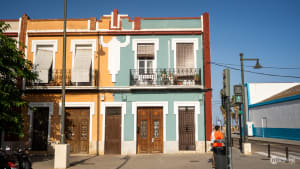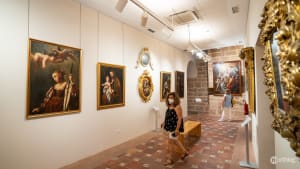
Castillos de Fuegos Artificiales
A nightly appointment for all Valencians under Fallas, when the sky shatters into droplets of light and glistening colours
Castillos de Fuegos Artificiales in a nutshell…
Every March night, Valencia’s sky erupts in dazzling fireworks, lighting up the city as part of Fallas. These spectacular displays, known as Castillos de Fuegos Artificiales, offer a breathtaking mix of color, rhythm, and Valencian passion for pyrotechnics.
Locations: Plaza del Ayuntamiento (March 15), Turia Park (March 16–19)
Key displays: Albà de les Falles (March 15th - Plaza del Ayuntamiento), Nit del Foc, the biggest and longest show (March 18th - Turia Park)
Duration: 15–20 minutes per show
Best viewing spots: Bridges near the Turia Park (Puente del Real, Puente de Aragón), Plaza del Ayuntamiento for the Albà de les Falles
Every night during the month of March, the municipality of Valencia and the local pyrotechnics organise stunning and elaborate firework displays called Castillos de Fuegos Artificiales (literally meaning Firework Castles)
While the loud Mascletás are ideal for the daytime, the Castillos are made to amaze the public with colourful twirls and sparkling shapes in the night sky. Nonetheless, remember this is still Valencia after all, so these fireworks will be much louder than the ones you have heard on other occasions.

In Valencia, the Castillos de Fuegos explode in colourful sparks and create playful shapes. The dark spring sky is engraved with fleeting constellations. Dozens of shimmering brushstrokes gently fade away, leaving behind only the acrid smell of gunpowder.
A typical Castillo is quite long compared to a regular firework display - generally around 15 minutes - although the duration varies depending on the night. The longest event is the Nit del Foc, the last Castillo of every Fallas edition. Another special event is the Albà de les Falle s, which opens the Semana Fallera and precedes the Plantà. Other Castillos take place all throughout March.
The location too, depends on the night, and the various Fallas committees fire their own Castillos. In any case, the biggest and most notable displays are set up in the old Turia riverbed, along the 9th section of the Turia Park.
History
From China all the way to Spain, this is how fireworks got to Valencia, becoming a huge part of the local way of celebrating Fallas.
Around 200 BC - Primitive firecrackers
Proto-firecrackers were invented in China from bamboo stems.
Around 800 AD - Gunpowder
A Chinese alchemist mixed sulfur, charcoal, and potassium nitrate, inventing gunpowder. The powder was packed into bamboo tubes and lit on fire, thus becoming the first actual firework. These fireworks were used for celebrations and festivities. That of the pyrotechnician soon developed into an independent and respected profession during the Song dynasty (960–1279).
900-1200 - Fireworks brought to Spain
Fireworks were brought to Spain by the Moor expansion into the peninsula. They thus laid the foundations for a long-lasting tradition of gunpowder, especially in the eastern coast of Spain, where Valencia is.
1830 - Modern fireworks
Italian pyrotechnicians gave fireworks their modern colouration by adding metal salts to their chemical composition. However, other forms of colouring the smoke and flames already existed in China as early as the 14th century.
1930s - First Castillos de Fuegos
Castillos de Fuegos Artificiales started being organised on Saturdays and Sundays in March on the occasion of a primitive version of Fallas.
1942 - Integration into the programme
The Castillos de Fuegos Artificiales were officially incorporated into the Fallas events programme.
1980s - Current date
The programme started resembling the current one. The Nit del Foc started being celebrated on the night between the 18th and the 19th, and other Castillos de Fuegos were established.
2016 - Albà de les Falles
This 1966-67 tradition was recovered and established as part of the official pyrotechnic programme.
Practical Information
The Castillos de Fuegos are normally held at night between the 15th and the 19th of March.
| Event |
|---|
| L’Alba de les Falles |
| Castillo de Fuegos |
| Castillo de Fuegos |
| Nit de Foc |
You can see the location for those that are not held at Plaza del Ayuntamiento on the map here.
Restricted Areas
Access to the sites is restricted for safety reasons. For this reason, it is forbidden to enter the enclosure in Plaza del Ayuntamiento on the 15th at night. All the other Castillos de Fuegos take place in the 9th tramo of the Turia Park. Access to that section is therefore forbidden.
To be specific, the closed off bridges for the occasion are: Puente de la Exposición, Puente de las Flores, Puente del Mar.

In terms of streets, the whole Passeig de Ciutadella and the stretch of the Alameda between Puente de la Exposición and Puente del Mar are off-limits. Additionally, Puente del Real and Puente de Aragón are also closed off for vehicles.
In any case, we recommend you get there on foot or by public transport.
Best spots to watch the firework displays
To see the Alba de les Falles it’s best to be in Plaza del Ayuntamiento. If you want an excellent view of the show, hotels and apartments rent rooms with a view of the square.
For the Castillos in the Turia Park, it’s best to be on the nearby bridges or at the sides of the park. This means Puente del Real and the Puente de Aragón offer an excellent view - there will be no cars allowed on them so you can safely occupy the bridges.
You can also go to either end of Puente de Aragón (with Plaza de América and Plaza Zaragoza). Other viable options are the area surrounding the kiosk La Pérgola on the Alameda or even Calle de l’Arquitecte Mora and its surroundings.
Our recommendations
When choosing a spot to watch the Castillos de Fuegos, always make sure that your view is not impeded by trees or urban architecture.
Try to go early, as many people are already starting to find a spot at least half an hour before the start of the display.
Transportation
The special safety measures that are put in place at the time of the Castillos de Fuegos can also affect public transport. A lot of EMT bus lines are also diverted, so the best is to ask the driver what the closest stop is.
Turia Park
The Alameda metro stop is generally closed before the display for safety reasons, so you shouldn’t take it into consideration when trying to get there.
| Method |
|---|
| Line |
| Stops |
Plaza del Ayuntamiento
| Method |
|---|
| Line |
| Stops |
Frequently Asked Questions
Here you can find quick answers to all of your questions. Linked, you’ll find the articles or the sections of the articles that can give you more detailed information.
-
They are nightly firework displays organised in Valencia during Fallas.
-
They take place between the beginning and the 19th of March.
If you’d like to know the detailed schedule, you can have a look at the dedicated section of this article.
-
They usually take place in the old Turia riverbed, in the 9th section of the park or the city’s Plaza del Ayuntamiento. However, the place depends on the individual event.
If you’d like to know the detailed schedule, you can have a look at the dedicated section of this article.
-
Although most Castillos are set off from the 9th section of the Turia Park, not all of them are. So, first, you should check the schedule for the event you intend to attend. Once you know that, you can have a look at our transport section to find out how to get to your destination, as well as the best spots to watch the event.



















